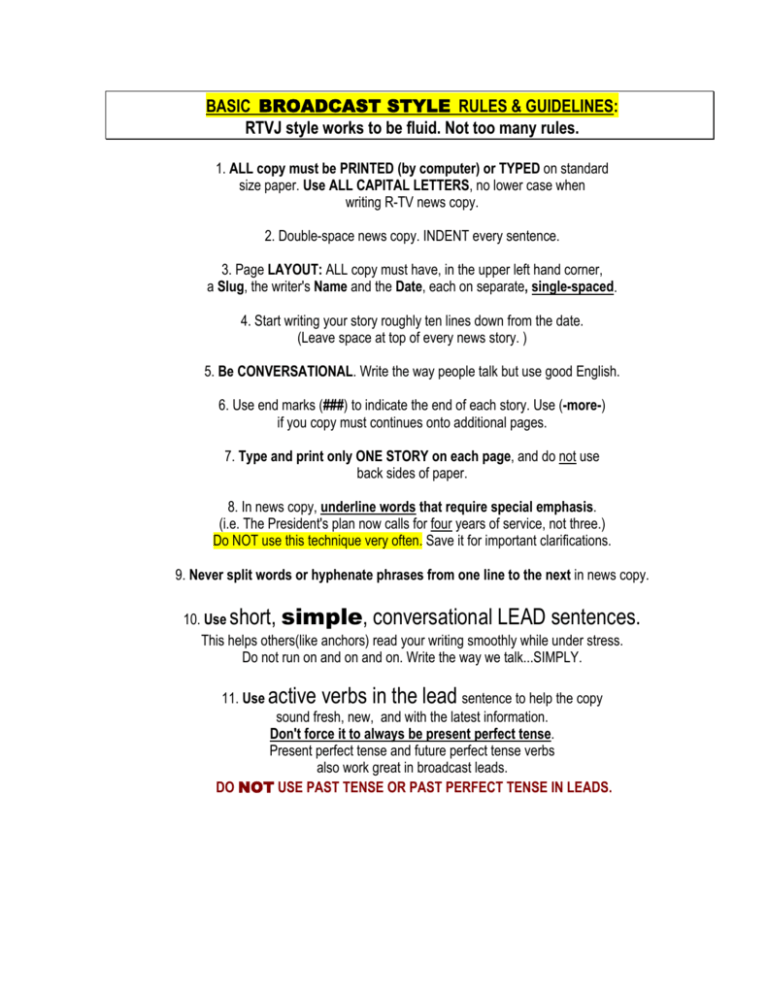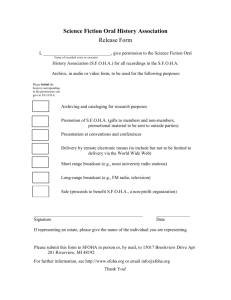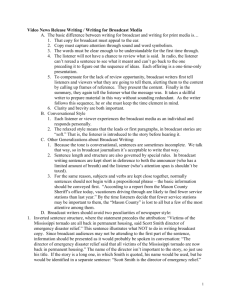RTVJ Style Rules
advertisement

BASIC BROADCAST STYLE RULES & GUIDELINES: RTVJ style works to be fluid. Not too many rules. 1. ALL copy must be PRINTED (by computer) or TYPED on standard size paper. Use ALL CAPITAL LETTERS, no lower case when writing R-TV news copy. 2. Double-space news copy. INDENT every sentence. 3. Page LAYOUT: ALL copy must have, in the upper left hand corner, a Slug, the writer's Name and the Date, each on separate, single-spaced. 4. Start writing your story roughly ten lines down from the date. (Leave space at top of every news story. ) 5. Be CONVERSATIONAL. Write the way people talk but use good English. 6. Use end marks (###) to indicate the end of each story. Use (-more-) if you copy must continues onto additional pages. 7. Type and print only ONE STORY on each page, and do not use back sides of paper. 8. In news copy, underline words that require special emphasis. (i.e. The President's plan now calls for four years of service, not three.) Do NOT use this technique very often. Save it for important clarifications. 9. Never split words or hyphenate phrases from one line to the next in news copy. 10. Use short, simple, conversational LEAD sentences. This helps others(like anchors) read your writing smoothly while under stress. Do not run on and on and on. Write the way we talk...SIMPLY. 11. Use active verbs in the lead sentence to help the copy sound fresh, new, and with the latest information. Don't force it to always be present perfect tense. Present perfect tense and future perfect tense verbs also work great in broadcast leads. DO NOT USE PAST TENSE OR PAST PERFECT TENSE IN LEADS. 12. Try to use active verbs THROUGHOUT the story whenever possible. Sometimes that works with some stories (like breaking news stories). Sometimes it does not work. Use your critical thinking skills and common sense. 13. Some traditional punctuation marks do not work in broadcast news copy. Do NOT use ellipsis (. . . ) Do NOT use quotation marks ( "..........."). That’s print style. In broadcast that can be misinterpreted by news anchors or reporters reading the story on-air. The audience in broadcast normally can not see quote marks either. 14. For strong, unique, or out of the ordinary comments instead of quote marks…say the word quote in your story: PRESIDENT BUSH SAYS -QUOTE- THE TERRORISTS HAVE ONE DAY TO COMPLY, OR ELSE. 15. Do NOT quote every comment precisely. That’s boring writing and lazy writing. Think it through and decide how unique/special/important the exact wording is. For basic reactions, responses or remarks, just paraphrase the comment. 16. Use the FIRST AND LAST NAMES of people in a news story the FIRST time they are mentioned. Thereafter in that story, use the last name to refer to that person, OR some other creative reference: I.E. MICHAEL JORDAN (the first time)...THE SIX-TIME N-B-A CHAMPION (thesecond time)...JORDAN (the third time)...THE FORMER CHICAGO BULL FORWARD (the fourth time)...back to JORDAN...etc. 17. NO UNFAMILIAR NAMES OR REFERENCES IN LEADS. Look for and use a familiar reference most listeners or viewers would grasp quick. Use that in the lead sentence. After the lead, then you can introduce the unfamiliar names, references, etc. 18. TITLES & DESCRIPTIVES GO BEFORE THE NAME in broadcast style. in broadcast copy. (i.e. Instead of : Bob Rucker, Associate Professor of Journalism, in broadcast say: JOURNALISM PROFESSOR KENNETH BLASÉ.) 19. Special titles / references: (To show proper respect...say: PRESIDENT BUSH (or) MR. BUSH (or) THE PRESIDENT; FIRST LADY LAURA BUSH (1st reference. Then: MRS. BUSH; POPE BENEDICT THE 16TH (or) THE POPE (or) THE HOLY FATHER To show proper respect for another head of state…put MISTER in front of the name when not using their title…i.e….British Prime Minister Tony Blair ( first reference ), then say MR. BLAIR 20. Try never to repeat information or exact wording within a story. Challenge yourself to say it another way. Be creative. Use your vocabulary to the max! Be conversational though. Don’t make things up. 21. Use only FAMILIAR ABBREVIATIONS like: MR., MRS., F-B-I, C-I-A, Y-W-C-A, Y-M-C-A, U-N, K-S-J-S, C-N-N, etc. NOTE: Some are said like words: ( NATO, AIDS ). If the abbreviation is not commonly known, do not use it on first reference. Spell out the full meaning the first time, then abbreviate. NUMBERS: 22. Round off ALL numbers EXCEPT when the number count is significant or the story itself. ( i.e. The death toll in a plane crash, the victim count in an earthquake, the heat related deaths, etc.) 23. SPELL OUT NUMBERS UP TO & INCLUDING ELEVEN, then use numerals (i.e. zero, one, two...eleven, 12, 13, ...66,...501...711... 999) or (i.e. first, second, third,...eleventh, 12th, etc.) SPELL OUT "HUNDRED," "THOUSAND," "MILLION," etc. references. (i.e. five-thousand, ten-million, 13-hundred, 56-thousand, 98-million, 111-billion.) TIME references: Follow the basic rules above, hyphenate, and specify "in the morning, evening or tonight." Do NOT use" am" or "pm." (i.e. two-15 this morning, noon, seven-45 this evening, at eleven tonight, midnight.) 24. Use 'ST' , 'RD' , 'TH' , and 'ND' appropriately after dates, addresses, and other unique number references. (i.e. NORTH 45TH STREET, ) 25. Age (numbers) go BEFORE names, and are hyphenated: (i.e. 78-YEAR-OLD BOB DOLE, TWO-MONTH OLD SUSAN LAKE) 26. After using the exact word, USE A PRONOUNCER AFTER, to help with saying difficult words: PRIME MINISTER IZATOOTE (E-ZA-TWO-TEA) IS AT THE WHITE HOUSE. 27. HAND EDIT your printed story & fix all style/spelling/grammar errors (Use broadcast style editing symbols and techniques, not print.) Completely darken out mistakes or words you do not want aired. Neatness is not everything. ACCURACY IS! Correct spelling, fact, and other errors. Be thorough. Take pride in your writing. 28. Use the broadcast news style insert bracket to change wording. Be absolutely clear where something is being added, changed or corrected. 29. CREATIVITY RULE: ALL copy CAN be written more than one Never tell yourself there is no other way to say something. Rewrites require changing leads, story structure, shuffling content, etc. Good writers enjoy the challenge of saying the same thing a different way. way. 30. PROFESSIONAL FLEXIBILITY & COURTESY. Each broadcast news operation works its own way, and usually develops its own identity and on-air style of reporting. (ie, ESPN writing is different from Local TV sports writing.) Pros are expected to adapt quickly to changes, and not let it bother them. JUST DO IT. When you move on to another broadcast class or internship, find out what the teacher or supervisor has established as their style, then immediately adopt it. NEVER CLING TO THE FAMILIAR & COMPLAIN WHEN STYLES CHANGE If you want to work in the media and make big bucks, get with the program and & thinking expected.







